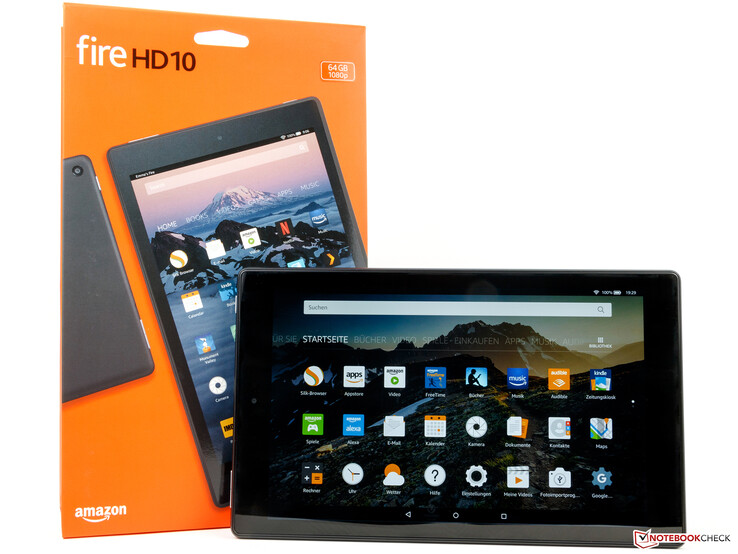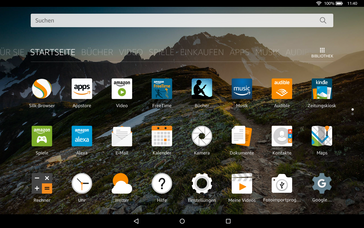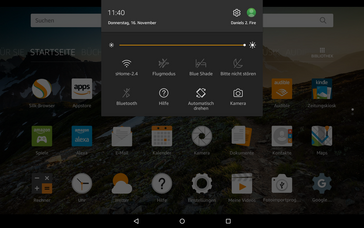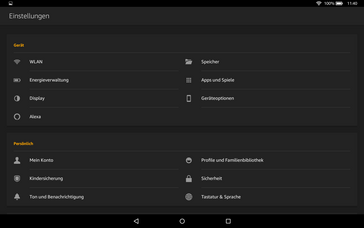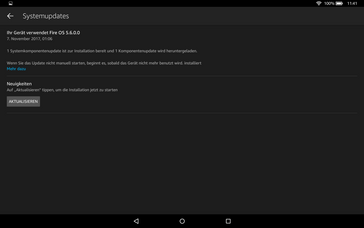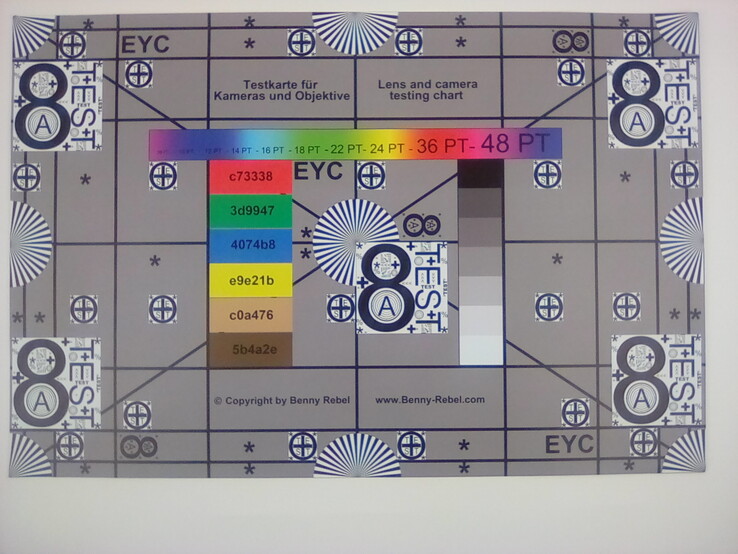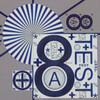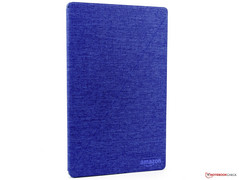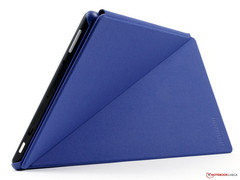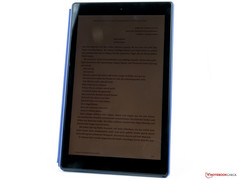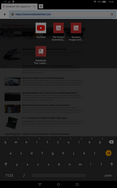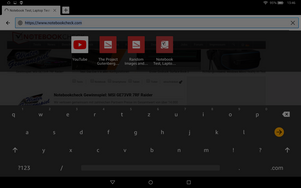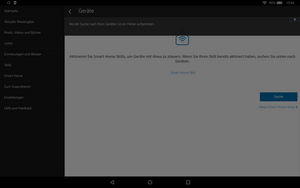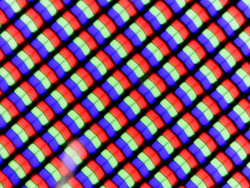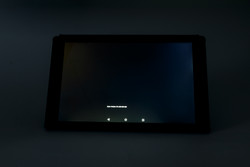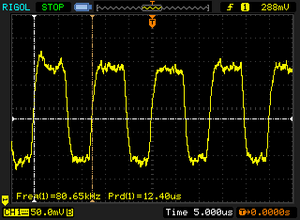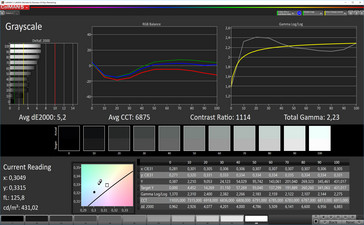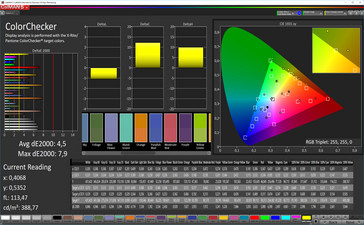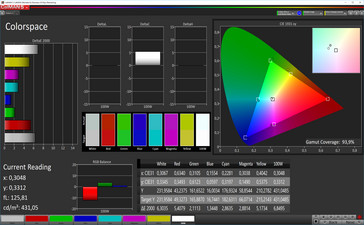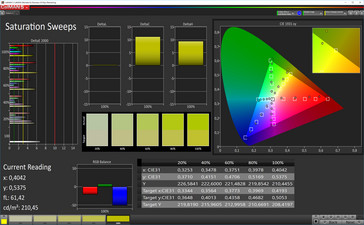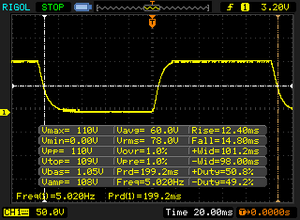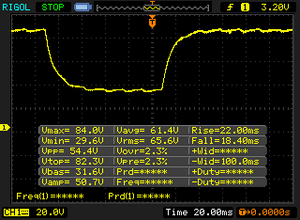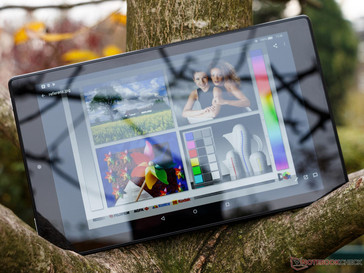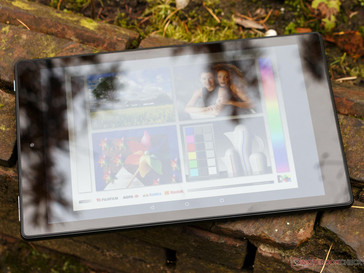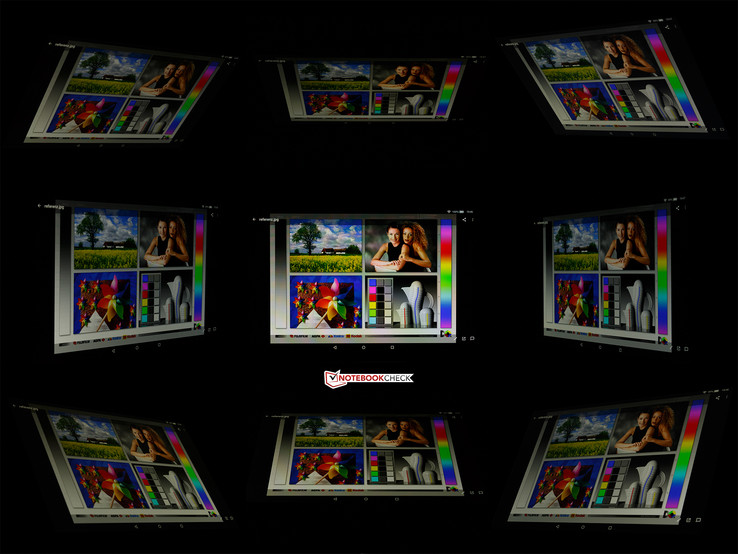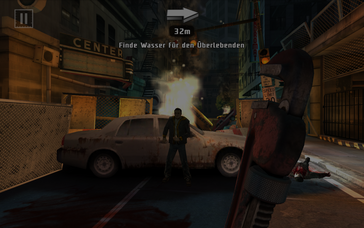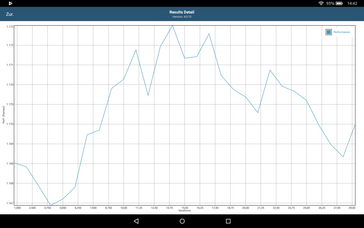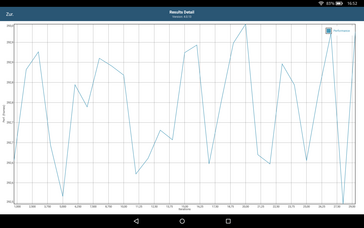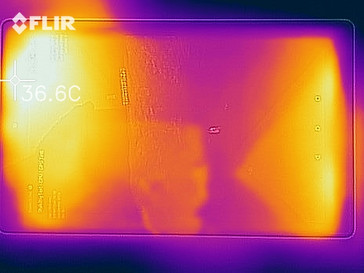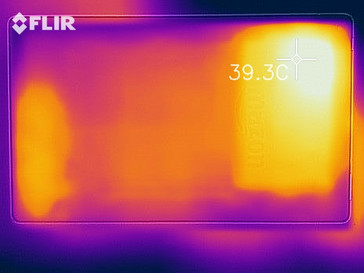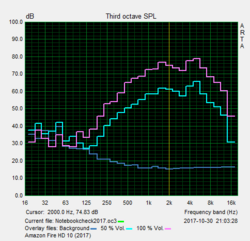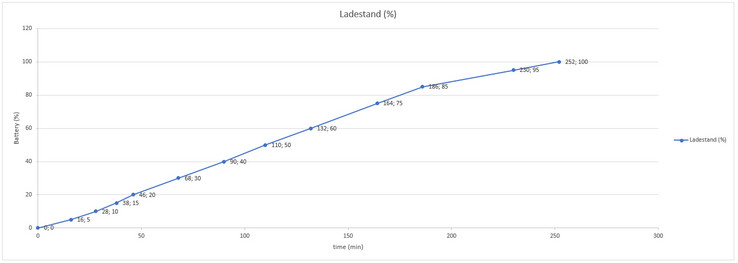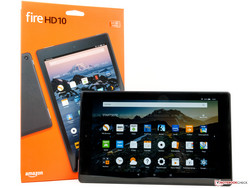Amazon Fire HD 10 (2017) Tablet Review
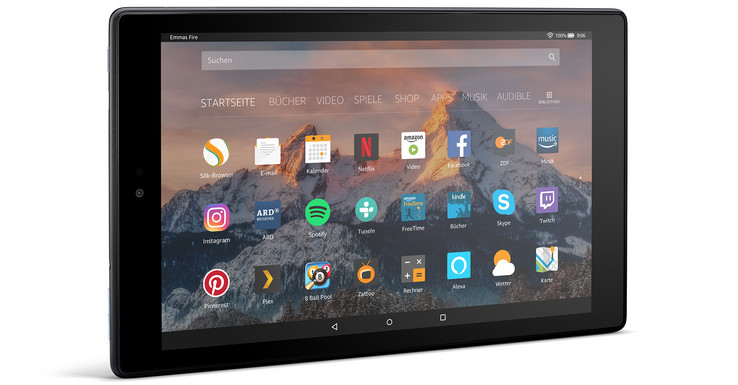
For the original German review, see here.
Amazon Fire Tablets are synonymous with comparably low prices. However, it quickly becomes apparent that low prices come with a cost of their own, especially when using the Fire 7 or the Fire HD 8. We are therefore surprised to find that the seventh generation Amazon Fire HD 10 has few limitations, and is designed above all to be a home multimedia device for Amazon users. To this end, the tablet has a high-resolution display, stereo speakers and an SoC that is quite strong, even though it is no longer of the latest generation. The voice assistant Alexa is also on board. The device comes in either 32 or 64 GB variants, both of which can be expanded with a micro-SD card. Those who default to special offers will receive a tablet that has advertisements on the lock screen, but is fifteen Euros (~$18) cheaper. The advertisements can also be removed later, at a cost. The 32 GB variant costs about 180 Euros (~$214) with special offers. Those that decide upon the larger model without advertisements will need to cough up no more than 225 Euros (~$268). Amazon Prime members receive a general discount of 20 Euros (~$24), which means the Fire HD 10 can be had at a starting price of 160 Euros (~$190).
The market for tablets is not particularly lively, which is why the competition is limited. The Acer Iconia Tab 10 (A3-A50), also a multimedia-oriented Tablet, can definitely be included. The Asus ZenPad 3s 10 Z500M is similar in terms of specifications, and the Lenovo Tab 4 10 as well as the Huawei Mediapad T3 10 are at a similar price point. For reference, we will also take the Apple iPad (2017) into the comparison field.
Case
The Amazon Fire HD 10 (2017) weighs about 500 grams (~1.1 lb) and sits well in the hand because of its rounded-off edges. The case is entirely made out of plastic. The slightly rough black surface is easy to grip, although fingerprints quickly become noticeable. In addition, even small scratches are visible on the chassis, which is why we recommend the use of the optional protective case.
Purely in terms of cosmetics, the tablet looks neither delicate nor stylish, but fit for purpose and rather like a product from previous years. However, this is not particularly annoying. The micro-SD card slot is protected by a cover and can be opened without an additional tool. The battery is built in, and there is no protection against dust and water.
Connections
The connections on the Amazon Fire HD 10 (2017) are quite spartan and limited to only the essentials. The micro-USB port transfers data on the 2.0 standard and does not support video display, although it does support OTG, which allows external peripheral devices and storage solutions to be connected.
The micro-SD card slot accepts SDHC as well as SDXC standards and according to the manufacturer, it supports cards of up to 256 GB. However, larger storage devices should also work fine. Both media and apps can be stored on the micro-SD card.
Bluetooth 4.1 is supported, NFC is not. It is also not possible to mirror the display on an external device using Miracast.
Software
Amazon relies on their proprietary Fire OS 5.6, based on the outdated Android 5.1 Lollipop, as the operating system. Those who can already claim to own a Fire tablet will quickly find their bearings. The user interface is deliberately adapted to suit Amazon’s offerings, and the manufacturer has preloaded its own app store. This does not offer nearly as wide a range as the Google Play Store, which, like the other Google services, is not pre-installed. Those wishing to use Google’s variety can manually install the necessary apps afterwards.
The apps and additionally loadable services of the Amazon Fire HD 10 (2017) are identical with those of the Fire 7 or Fire HD 8. The ability to use the voice assistant Alexa is new in the Fire HD 10, although it is also available in the smart speaker Amazon Echo Dot, among other places
It is difficult to say how safe the old version of Android is as Amazon does not allow deep access into the system and keeps its options light. However, updates are regularly rolled out by the Americans. For the most part, the updates install themselves automatically while in use and do not require a restart.
Communication
The Amazon Fire HD 10 (2017) is equipped only with a Wi-Fi module; there is no LTE variant. The IEEE-802.11 standards are supported, and the tablet supports both the 2.4 GHz and the 5.0 GHz networks. As expected, MIMO radio technology is not built in, so the measured transfer speeds to our reference router Linksys EA8500 are only acceptable. In the immediate vicinity of the Access Point (AP), the attenuation on the 2.4 GHz network is in a good spot at -38 dBm. Even at 12 m (~39 ft) away from the AP, the -70 dBm attenuation is still reasonable, although it is no longer sufficient for comfortable web browsing, not to mention video streaming. This is why we can only certify the Fire HD 10 as ‘average’ in terms of radio range.
There is no built-in GPS module, which means that positioning can only take place over Wi-Fi.
| Networking | |
| iperf3 transmit AX12 | |
| Apple iPad (2017) | |
| Asus ZenPad 3s 10 Z500M | |
| Amazon Fire HD 10 2017 | |
| Huawei MediaPad T3 10 | |
| Lenovo Tab 4 10 | |
| iperf3 receive AX12 | |
| Apple iPad (2017) | |
| Asus ZenPad 3s 10 Z500M | |
| Amazon Fire HD 10 2017 | |
| Huawei MediaPad T3 10 | |
| Lenovo Tab 4 10 | |
Cameras
One look at the technical specifications of the camera on the Amazon Fire HD 10 (2017) already reveals that cameras are not for photo hobbyists. The tablet offers a bland diet of 0.3 megapixels on the front and 2.0 megapixels on the back. The capture quality is correspondingly poor. The front camera is in the best of cases sufficient for video calls under good lighting conditions, and even here should the bar not be set too high.
Although the main camera has a somewhat higher resolution, it too is qualitatively miles away from budget entry devices. The photos are somewhat blurry even under daylight, details are lost in a mash of pixels, and differences in lighting conditions ensure partial overexposure. A surprisingly large amount of light is captured under weak lighting conditions, although the resulting images are dreadful.
Video quality paints a similar picture and can only be captured in a 1280x720 pixel resolution.
The main camera is not convincing even under controlled lighting conditions. The pictures are not sharp and are wrought with strong chromatic aberrations. The colors are very oversaturated and shades of gray look lackluster.
Accessories and Warranty
In the packaging of the Amazon Fire HD 10 (2017), there is a modular power adaptor with a stated performance of 9.36 watts (5.2 Volts, 1.8 Ampere), a USB cable, a quick start guide and a foldout with the conditions of the warranty. The manufacturer offers an optional protective case (30 Euros) (~$36) in several colors. The case is well manufactured and can also serve as a stand for the tablet in both portrait and landscape orientations.
Amazon only offers 12 months of warranty on its products; retailers’ guarantees are not affected by this policy. Please see our Guarantees, Return Policies & Warranties FAQ for country-specific information.
Input Devices and Handling
The capacitive touchscreen on the Amazon Fire HD 10 (2017) supports up to ten finger multi-touch, works well even around the edges and has good gliding properties. The physical buttons for power and volume controls are made of plastic, have clear pressure points and work reliably. Their positioning takes a bit of getting used to, however.
The seventh generation Fire HD 10 is the first mobile device from Amazon with the integrated Alexa assistant. The assistant works well as expected, and we have already scrutinized it more closely in our test against the Amazon Echo Dot. However, the function to search for new Smart Home devices did not work and resulted in error messages. Amazon will surely make improvements in this area with an update.
Display
The Amazon Fire HD 10 (2017) has a 10.1-inch (25.65 cm) IPS display at a 1920x1200 resolution. The pixel density is therefore at an acceptable level, and there are no visible blocky or blurred images when the screen is viewed at usual distances.
The panel’s brightness is more than acceptable at 399 cd/m². Moreover, the illumination is also very even. Together with a good black value of 0.38 cd/m², this results in a strong contrast ratio if 1.121:1. The measured values remain constant even under a uniform distribution of light and dark surfaces (APL 50) as well as with the ambient light sensor activated.
The display on the Fire HD 10 is not entirely free of clouding. However, this is only visible on a completely black screen in dark lighting conditions and is not disruptive to day-to-day use.
| |||||||||||||||||||||||||
Brightness Distribution: 91 %
Center on Battery: 426 cd/m²
Contrast: 1121:1 (Black: 0.38 cd/m²)
ΔE ColorChecker Calman: 4.5 | ∀{0.5-29.43 Ø4.77}
ΔE Greyscale Calman: 5.2 | ∀{0.09-98 Ø5}
Gamma: 2.23
CCT: 6875 K
| Amazon Fire HD 10 2017 IPS, 1920x1200, 10.1" | Asus ZenPad 3s 10 Z500M IPS, 2048x1536, 9.7" | Lenovo Tab 4 10 IPS, 1280x800, 10.1" | Huawei MediaPad T3 10 IPS, 1280x800, 9.6" | Apple iPad (2017) IPS, 2048x1536, 9.7" | |
|---|---|---|---|---|---|
| Screen | -11% | 0% | 2% | 26% | |
| Brightness middle (cd/m²) | 426 | 489 15% | 316 -26% | 410 -4% | 514 21% |
| Brightness (cd/m²) | 399 | 443 11% | 305 -24% | 409 3% | 485 22% |
| Brightness Distribution (%) | 91 | 86 -5% | 86 -5% | 92 1% | 88 -3% |
| Black Level * (cd/m²) | 0.38 | 0.43 -13% | 0.2 47% | 0.32 16% | 0.46 -21% |
| Contrast (:1) | 1121 | 1137 1% | 1580 41% | 1281 14% | 1117 0% |
| Colorchecker dE 2000 * | 4.5 | 5.5 -22% | 5 -11% | 4.5 -0% | 1.4 69% |
| Colorchecker dE 2000 max. * | 7.9 | 11.6 -47% | 8.7 -10% | 14.2 -80% | 2.9 63% |
| Greyscale dE 2000 * | 5.2 | 6.7 -29% | 5.7 -10% | 2 62% | 2.1 60% |
| Gamma | 2.23 99% | 2.06 107% | 2.25 98% | 2.17 101% | 2.22 99% |
| CCT | 6875 95% | 7457 87% | 7921 82% | 6930 94% | 6647 98% |
* ... smaller is better
Screen Flickering / PWM (Pulse-Width Modulation)
| Screen flickering / PWM detected | 80650 Hz | ≤ 55 % brightness setting | |
The display backlight flickers at 80650 Hz (worst case, e.g., utilizing PWM) Flickering detected at a brightness setting of 55 % and below. There should be no flickering or PWM above this brightness setting. The frequency of 80650 Hz is quite high, so most users sensitive to PWM should not notice any flickering. In comparison: 53 % of all tested devices do not use PWM to dim the display. If PWM was detected, an average of 8084 (minimum: 5 - maximum: 343500) Hz was measured. | |||
Pulse width modulation is used in the Amazon Fire HD 10 (2017), albeit at a higher frequency than usual, so that even sensitive users should have no issues. Moreover, the minimal brightness of under 4 cd/m² is very low, which is why the tablet, in combination with the blue light filter, is suited for enjoying some evening reading without too much eyestrain.
We have more closely examined the color production of the tablet with a photospectrometer and the analysis software CalMAN. In light of the price range, the deviations are tolerable and not too apparent in daily use; the gentle green cast in the grayscales makes images look a little sickly at flat viewing angles.
Display Response Times
| ↔ Response Time Black to White | ||
|---|---|---|
| 37.2 ms ... rise ↗ and fall ↘ combined | ↗ 12.4 ms rise | |
| ↘ 14.8 ms fall | ||
| The screen shows slow response rates in our tests and will be unsatisfactory for gamers. In comparison, all tested devices range from 0.1 (minimum) to 240 (maximum) ms. » 95 % of all devices are better. This means that the measured response time is worse than the average of all tested devices (20.2 ms). | ||
| ↔ Response Time 50% Grey to 80% Grey | ||
| 40.4 ms ... rise ↗ and fall ↘ combined | ↗ 22 ms rise | |
| ↘ 18.4 ms fall | ||
| The screen shows slow response rates in our tests and will be unsatisfactory for gamers. In comparison, all tested devices range from 0.165 (minimum) to 636 (maximum) ms. » 63 % of all devices are better. This means that the measured response time is worse than the average of all tested devices (31.6 ms). | ||
The Amazon Fire HD 10 (2017) performs quite well in the open, as long as it is not placed against direct sunlight. In this scenario, the reflections of the display surface are quite annoying and the brightness of the tablet is no longer sufficient. However, shady areas or cloudy skies pose no problem.
The stability of the viewing angle on the Amazon Fire HD 10 (2017) is good, as expected. The IPS panel does not allow for color inversions and ghost effects, although slight losses in brightness as well as the aforementioned greenish tint are visible at flat viewing angles. However, neither is of particular consequence in daily use.
Performance
With a MediaTek MT8173 SoC, the Amazon Fire HD 10 (2017) has comparatively strong specifications and offers top-class performance at the price of an entry-level device. In addition, there is 2 GB RAM as well as an Imagination PowerVR GX6250 graphics unit. However, this package is no longer brand new, which is particularly apparent in terms of the GPU. For example, it does not support all modern APIs such as Vulkan.
The Fire HD 10 (2017) performs well in system and CPU benchmarks, and sometimes offers considerably more computing power than the competition from Lenovo and Huawei. Even the device’s graphics benchmarking is substantially above those of the aforementioned competitors despite the fact that the Fire has to work through a higher resolution.
| AnTuTu v6 - Total Score | |
| Apple iPad (2017) | |
| Asus ZenPad 3s 10 Z500M | |
| Amazon Fire HD 10 2017 | |
| Huawei MediaPad T3 10 | |
| Lenovo Tab 4 10 | |
| PCMark for Android | |
| Work performance score | |
| Amazon Fire HD 10 2017 | |
| Huawei MediaPad T3 10 | |
| Lenovo Tab 4 10 | |
| Asus ZenPad 3s 10 Z500M | |
| Work 2.0 performance score | |
| Amazon Fire HD 10 2017 | |
| Huawei MediaPad T3 10 | |
| Lenovo Tab 4 10 | |
| Geekbench 4.4 | |
| 64 Bit Single-Core Score | |
| Amazon Fire HD 10 2017 | |
| Lenovo Tab 4 10 | |
| Huawei MediaPad T3 10 | |
| 64 Bit Multi-Core Score | |
| Amazon Fire HD 10 2017 | |
| Lenovo Tab 4 10 | |
| Huawei MediaPad T3 10 | |
| Compute RenderScript Score | |
| Amazon Fire HD 10 2017 | |
| Lenovo Tab 4 10 | |
| GFXBench (DX / GLBenchmark) 2.7 | |
| T-Rex Onscreen | |
| Apple iPad (2017) | |
| Asus ZenPad 3s 10 Z500M | |
| Amazon Fire HD 10 2017 | |
| Huawei MediaPad T3 10 | |
| Lenovo Tab 4 10 | |
| 1920x1080 T-Rex Offscreen | |
| Apple iPad (2017) | |
| Asus ZenPad 3s 10 Z500M | |
| Amazon Fire HD 10 2017 | |
| Lenovo Tab 4 10 | |
| Huawei MediaPad T3 10 | |
| GFXBench 3.0 | |
| on screen Manhattan Onscreen OGL | |
| Apple iPad (2017) | |
| Asus ZenPad 3s 10 Z500M | |
| Amazon Fire HD 10 2017 | |
| Huawei MediaPad T3 10 | |
| Lenovo Tab 4 10 | |
| 1920x1080 1080p Manhattan Offscreen | |
| Apple iPad (2017) | |
| Asus ZenPad 3s 10 Z500M | |
| Amazon Fire HD 10 2017 | |
| Lenovo Tab 4 10 | |
| Huawei MediaPad T3 10 | |
| GFXBench 3.1 | |
| on screen Manhattan ES 3.1 Onscreen | |
| Apple iPad (2017) | |
| Amazon Fire HD 10 2017 | |
| Asus ZenPad 3s 10 Z500M | |
| 1920x1080 Manhattan ES 3.1 Offscreen | |
| Apple iPad (2017) | |
| Amazon Fire HD 10 2017 | |
| Asus ZenPad 3s 10 Z500M | |
| GFXBench | |
| on screen Car Chase Onscreen | |
| Amazon Fire HD 10 2017 | |
| Asus ZenPad 3s 10 Z500M | |
| 1920x1080 Car Chase Offscreen | |
| Amazon Fire HD 10 2017 | |
| Asus ZenPad 3s 10 Z500M | |
| Basemark ES 3.1 / Metal - offscreen Overall Score | |
| Apple iPad (2017) | |
Amazon has preloaded its own Silk Browser. This performs quite well in benchmarks and allows for pleasant surfing through the World Wide Web. In Google Octane 2.0 and the WebXPRT 2015, the Fire HD 10 (2017) performs even better than the nominally faster Zenpad 3s 10.
| Octane V2 - Total Score | |
| Apple iPad (2017) | |
| Amazon Fire HD 10 2017 (Amazon Silk 61.2) | |
| Asus ZenPad 3s 10 Z500M (Chrome 55) | |
| Lenovo Tab 4 10 (Chrome 60) | |
| Huawei MediaPad T3 10 (Chrome 58) | |
| WebXPRT 2015 - Overall | |
| Apple iPad (2017) | |
| Amazon Fire HD 10 2017 (Amazon Silk 61.2) | |
| Asus ZenPad 3s 10 Z500M (Chrome 55) | |
| Huawei MediaPad T3 10 (Chrome 58) | |
| Lenovo Tab 4 10 (Chrome 60) | |
| JetStream 1.1 - Total Score | |
| Apple iPad (2017) | |
| Asus ZenPad 3s 10 Z500M (Chrome 55) | |
| Amazon Fire HD 10 2017 (Amazon Silk 61.2) | |
| Huawei MediaPad T3 10 (Chrome 58) | |
| Mozilla Kraken 1.1 - Total | |
| Huawei MediaPad T3 10 (Chrome 58) | |
| Lenovo Tab 4 10 (Chrome 60) | |
| Amazon Fire HD 10 2017 (Amazon Silk 61.2) | |
| Asus ZenPad 3s 10 Z500M (Chrome 55) | |
| Apple iPad (2017) | |
* ... smaller is better
The Amazon Fire HD 10 (2017) has optionally 32 or 64 GB of storage, which is expandable via a micro-SD card. Our test device is the stronger variant and performs at the expected level in our speed test, although it paints a better picture overall than its competitors.
We checked the micro-SD card slot with our reference Toshiba Exceria Pro M501 (Max: 270MB/s read, 150MB/s write). Although the micro-SD slot is not slow, it does not come close to using the full potential of the memory module.
| Amazon Fire HD 10 2017 | Asus ZenPad 3s 10 Z500M | Lenovo Tab 4 10 | Huawei MediaPad T3 10 | |
|---|---|---|---|---|
| AndroBench 3-5 | -16% | 17% | 12% | |
| Sequential Read 256KB (MB/s) | 262.2 | 209.3 -20% | 275 5% | 154.7 -41% |
| Sequential Write 256KB (MB/s) | 147.7 | 136.5 -8% | 45.3 -69% | 41.1 -72% |
| Random Read 4KB (MB/s) | 27.72 | 24.85 -10% | 32.3 17% | 50 80% |
| Random Write 4KB (MB/s) | 9.37 | 6.8 -27% | 8.9 -5% | 5.3 -43% |
| Sequential Read 256KB SDCard (MB/s) | 55.5 ? | 45.15 ? -19% | 84.5 52% | 83 ? 50% |
| Sequential Write 256KB SDCard (MB/s) | 30.14 ? | 26.9 ? -11% | 59.9 99% | 58.7 ? 95% |
Gaming
The PowerVR GX6250 on board the Amazon Fire HD 10 (2017) is quite an old GPU, which in turn has to put out quite a high resolution on the display. All games are playable on it, although, as our benchmarks with the racing game Asphalt 8 show, the tablet runs up against its limits on high graphics settings and cannot render the game smoothly. Other titles such as Dead Trigger 2 are limited to 30 fps from the get go.
The position sensor and the touchscreen function flawlessly, although the tablet itself is too heavy for long periods of action gaming. Quite a shame actually, as the speakers ensure comparatively good sound quality and are well positioned.
| Asphalt 8: Airborne | |||
| Settings | Value | ||
| high | 22 fps | ||
| very low | 30 fps | ||
| Temple Run 2 | |||
| Settings | Value | ||
| default | 60 fps | ||
| Dead Trigger 2 | |||
| Settings | Value | ||
| high | 30 fps | ||
Emissions
Temperature
The surface temperatures on the Amazon Fire HD 10 (2017) are very low when idling, not even scratching at the 30 °C (86 °F) mark. Under load, the temperatures tend to climb up to 40 °C (104 °F), which is noticeable to the touch, although neither unpleasant nor critical.
We analyzed how the SoC deals with rising heat levels with the help of the GFXBench Battery Test. The tablet had no problems there. In both the T-Rex test and the more demanding Manhattan test, we cannot see any signs of throttling.
(+) The maximum temperature on the upper side is 36.1 °C / 97 F, compared to the average of 33.6 °C / 92 F, ranging from 20.7 to 53.2 °C for the class Tablet.
(+) The bottom heats up to a maximum of 39.9 °C / 104 F, compared to the average of 33.2 °C / 92 F
(+) In idle usage, the average temperature for the upper side is 25.2 °C / 77 F, compared to the device average of 30 °C / 86 F.
Speakers
There are two stereo speakers on the top edge of the Amazon Fire HD 10 (2017). This positioning is particularly practical when consuming media as the loudspeakers cannot be covered. Moreover, Dolby Atmos is on board, although we were unable to make out any opportunities to adjust its options or any other signs of its existence.
The speakers provide comparatively good sounds with a linear frequency response in terms of pink noise measurements. It is only the high frequencies that are too prominent while the basses are lacking. The tablet is more than satisfactory for watching TV shows on the couch; the range of sounds is not good enough for music.
External speakers or headphones can be connected and controlled via Bluetooth or with the 3.5 mm headphone jack, the latter of which performs its job very well and delivers a low-noise audio signal with high output volume.
Amazon Fire HD 10 2017 audio analysis
(+) | speakers can play relatively loud (86.1 dB)
Bass 100 - 315 Hz
(-) | nearly no bass - on average 24.1% lower than median
(±) | linearity of bass is average (10.6% delta to prev. frequency)
Mids 400 - 2000 Hz
(+) | balanced mids - only 4.8% away from median
(+) | mids are linear (5.9% delta to prev. frequency)
Highs 2 - 16 kHz
(±) | higher highs - on average 5.8% higher than median
(+) | highs are linear (6.5% delta to prev. frequency)
Overall 100 - 16.000 Hz
(±) | linearity of overall sound is average (21.5% difference to median)
Compared to same class
» 65% of all tested devices in this class were better, 5% similar, 30% worse
» The best had a delta of 7%, average was 20%, worst was 129%
Compared to all devices tested
» 60% of all tested devices were better, 7% similar, 33% worse
» The best had a delta of 4%, average was 24%, worst was 134%
Asus ZenPad 3s 10 Z500M audio analysis
(+) | speakers can play relatively loud (95 dB)
Bass 100 - 315 Hz
(-) | nearly no bass - on average 24% lower than median
(+) | bass is linear (5% delta to prev. frequency)
Mids 400 - 2000 Hz
(±) | reduced mids - on average 5.4% lower than median
(+) | mids are linear (4.2% delta to prev. frequency)
Highs 2 - 16 kHz
(±) | higher highs - on average 5.7% higher than median
(+) | highs are linear (5.3% delta to prev. frequency)
Overall 100 - 16.000 Hz
(±) | linearity of overall sound is average (18.4% difference to median)
Compared to same class
» 48% of all tested devices in this class were better, 6% similar, 47% worse
» The best had a delta of 7%, average was 20%, worst was 129%
Compared to all devices tested
» 40% of all tested devices were better, 8% similar, 52% worse
» The best had a delta of 4%, average was 24%, worst was 134%
Huawei MediaPad T3 10 audio analysis
(+) | speakers can play relatively loud (87.2 dB)
Bass 100 - 315 Hz
(-) | nearly no bass - on average 32.3% lower than median
(±) | linearity of bass is average (9.4% delta to prev. frequency)
Mids 400 - 2000 Hz
(±) | reduced mids - on average 5.6% lower than median
(±) | linearity of mids is average (7.6% delta to prev. frequency)
Highs 2 - 16 kHz
(±) | higher highs - on average 7.8% higher than median
(+) | highs are linear (4.9% delta to prev. frequency)
Overall 100 - 16.000 Hz
(±) | linearity of overall sound is average (26.7% difference to median)
Compared to same class
» 83% of all tested devices in this class were better, 4% similar, 13% worse
» The best had a delta of 7%, average was 20%, worst was 129%
Compared to all devices tested
» 81% of all tested devices were better, 4% similar, 15% worse
» The best had a delta of 4%, average was 24%, worst was 134%
Frequency diagram for comparison (Check boxes above are (de)selectable!)
Energy Management
Power Consumption
The energy consumption of the Amazon Fire HD 10 (2017) is somewhat too high; above all, it should be a little lower when idle. Among the competition, the Lenovo Tab 4 10 requires less energy, although it does have a lower display resolution. The powerful SoC takes its due under load and significantly drains the battery.
The manufacturer specifies the charging time of the 6,300-mAh battery at around five hours. In our test, the charging was completed in four hours and eleven minutes, which is somewhat faster, although still extremely slow. Fast charging technology would definitely have been something to wish for.
| Off / Standby | |
| Idle | |
| Load |
|
Key:
min: | |
| Amazon Fire HD 10 2017 6300 mAh | Asus ZenPad 3s 10 Z500M 5900 mAh | Lenovo Tab 4 10 7000 mAh | Apple iPad (2017) 8.827 mAh | |
|---|---|---|---|---|
| Power Consumption | -15% | 22% | -50% | |
| Idle Minimum * (Watt) | 1.55 | 1.59 -3% | 1.09 30% | 2.06 -33% |
| Idle Average * (Watt) | 4.17 | 4.14 1% | 3.71 11% | 7.42 -78% |
| Idle Maximum * (Watt) | 4.25 | 4.23 -0% | 3.84 10% | 7.47 -76% |
| Load Average * (Watt) | 7.13 | 10.89 -53% | 5.07 29% | 9.45 -33% |
| Load Maximum * (Watt) | 9.63 | 11.58 -20% | 6.88 29% | 12.31 -28% |
* ... smaller is better
Battery Life
In light of the power consumption, our expectations regarding the battery life on Amazon Fire HD 10 (2017) were somewhat muted. This is confirmed, most notably in our reading test, where our review unit does not last particularly long at sixteen hours, despite the fact that the display is quite dark on minimum brightness.
The battery tests offer the best comparison when surfing the web over Wi-Fi and endlessly playing Big Buck Bunny videos. Both of these tests are carried out with an adjusted display brightness of 150 cd/m². Among the competitors, only the MediaPad T3 had an even shorter battery life, although it does also have a significantly smaller battery. Above all, it is the iPad that justifies its markedly higher price with noticeably better battery performance.
When looking at the raw numbers, we are nonetheless able to certify the Fire HD 10 (2017) with quite a good total score. Additionally, there is an energy-saving mode, with which the battery life can be increased.
| Amazon Fire HD 10 2017 6300 mAh | Asus ZenPad 3s 10 Z500M 5900 mAh | Lenovo Tab 4 10 7000 mAh | Huawei MediaPad T3 10 4800 mAh | Apple iPad (2017) 8.827 mAh | |
|---|---|---|---|---|---|
| Battery runtime | 8% | 17% | -7% | 31% | |
| Reader / Idle (h) | 16 | 24.2 51% | 18.9 18% | 24.9 56% | |
| H.264 (h) | 9.8 | 10 2% | 8.8 -10% | 14.1 44% | |
| WiFi v1.3 (h) | 9 | 8.6 -4% | 10.5 17% | 7.3 -19% | 12.7 41% |
| Load (h) | 4.6 | 3.8 -17% | 3.8 -17% | 3.8 -17% |
Pros
Cons
Verdict
Those who purchase a seventh generation Amazon Fire HD 10 tablet will receive a multimedia specialist in Amazon's universe without any major shortcomings. It is exactly that which makes the device a real alternative and it is available for quite a low price.
On the plus side are a good display, decent speakers, fast Wi-Fi and a fast chipset that are usually only found in more expensive devices. On the other hand, the old base software that probably will not receive any further updates is a put-off.
The Amazon Fire HD 10 is a price-conscious alternative for media consumers.
To be sure, features such as NFC, aptX, GPS, Miracast, fast charging or a better array of sensors are missing. Moreover, Alexa did not yet run very smoothly, although this will be fixed in future with updates. Nevertheless, Amazon has a strong combined offering at an attractive price.
Amazon Fire HD 10 2017
- 11/05/2019 v7 (old)
Daniel Schmidt




